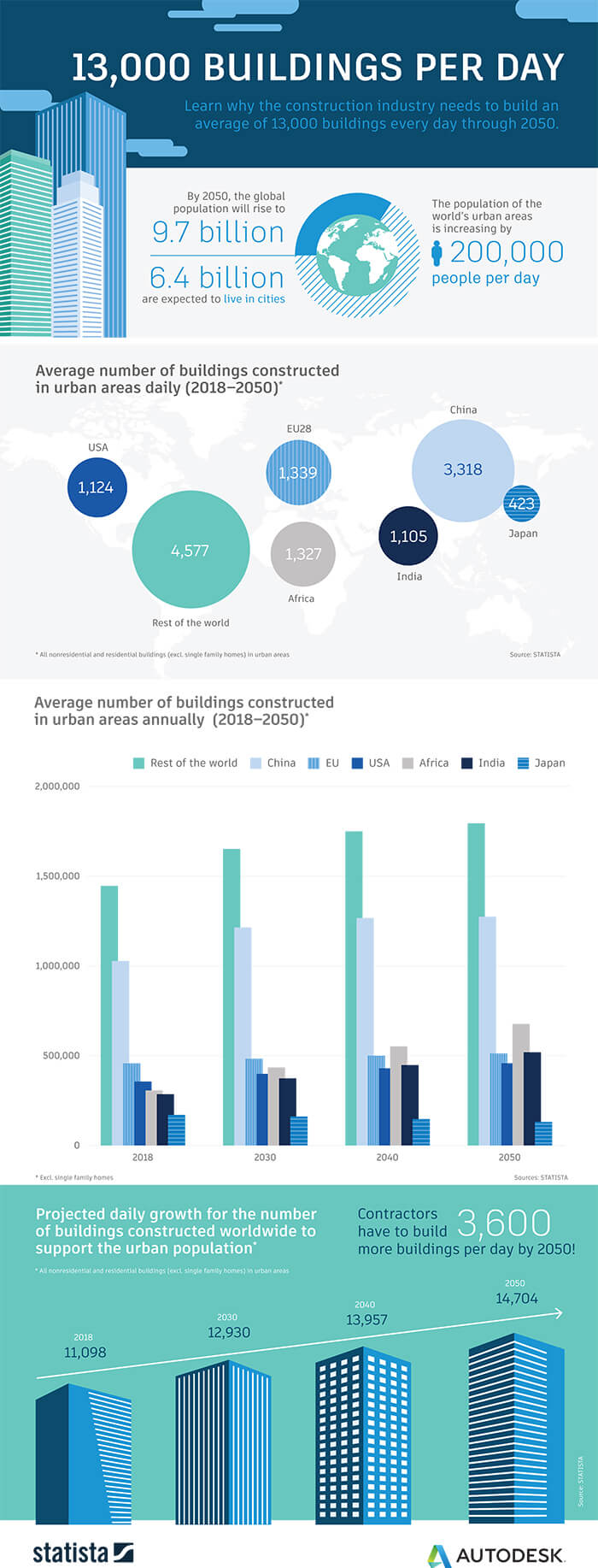In 2009, a significant change happened in our world. According to the United Nations, the number of people living in urban areas (3.42 billion people) surpassed the number of people living in rural locations (3.41 billion). For the first time, our world became more urban than rural.
The truth is, no matter which way you slice it, urbanization is reshaping the world. Around 200,000 people a day are moving from rural areas to major cities. By 2050, 10 billion people will walk this world, with two-thirds calling cities their home. Whether crowded into high-rise dwelling units or scattered around the edges of metropolitan sprawl, people will need homes, offices and amenities to fuel their rise and lifestyles.
Which means, of course, that construction has a pretty big job to do. In fact, it will need to produce an average of 13,000 buildings per day in order to keep up with demand, according to the following infographic from Redshift.

As you can see, contractors have a busy future ahead. And while that’s wonderful for jobs and the economy, and will no doubt prove a driving force in the next 30 years of human innovation, urbanization does bring with it plenty of new challenges. Below, we discuss four areas where architecture, design and building companies can help alleviate some of the problems that come from urbanization.
1. Sustainability
Today, more than ever, we need sustainability in all human efforts, and construction is no exception. Urbanization problems carry with them hefty price tags in terms of pollution, use of virgin resources, waste and the edging out of native plant and animal populations. Today, most city planners agree that sustainability needs to be built into urban planning from the start to be effective.
“The World Building Council for Sustainable Development says buildings account for 40% of worldwide energy use – which is more than transportation,” says Boss. While this is not always the case, construction teams can help support better energy consumption in new builds and renovations. Here are two key ways:
- By contributing to more sustainable building practices
- By building structures that contribute more positively to our environment
Consider the net zero building, which is one of our greatest hopes when it comes to urbanization problems: “net zero refers to buildings that are either ‘net zero energy’ (they produce as much renewable energy on-site as they consume annually) or ‘net zero carbon’ (they produce net zero carbon emissions on an annual basis).” Movements like this are among the most likely to solve the sustainability crisis this century.
2. Housing Shortage
Another of the world’s greatest urbanization problems at present? The housing shortage, which is being felt all over the nation and the world. To meet the rising population booms and city growth, design and construction teams will need to think strategically to maximize the use of space.
For many cities, this means building up. Take Denver for instance. In response to challenges, “cities are seeking to accommodate increasing populations amid housing shortages by growing up instead of out. A number of them, including this mile-high city hard against the Front Range, are considering projects that would construct some of the tallest buildings in the West.” However, when talking about building 70 stories and more, this brings its own challenges, such as obstruction of the city’s famous and cherished views.
Which is why other cities are looking at a different way to address the housing crisis, without walling off skylines, and innovative architecture might help. Ideas include live-work communities, adjustable dwellings with movable panels, townhomes and more.
3. Access to Infrastructure
For urban communities to flourish, there needs to be access to critical amenities and infrastructure–including housing. Currently, many cities around the world are already in dire need of infrastructure improvements, including crumbling roads, crippling traffic and deteriorating water supplies. If we cannot solve such urbanization problems, cities will indeed continue down a steady path of degradation.
Construction teams have a vital role to play to improve all of these things, with the help of governments and even aid organizations. But to truly meet the needs of these urban communities and see successful construction, teams will need to move fast, utilizing the right construction technology to provide teams with access to digital plans and documents as well as advanced models for planning and repair purposes.
Take, for instance, U.S. Department of Transportation. They have outlined a plan to address infrastructure deficiencies through innovation. While they have a long way to go, utilizing modern technology to build more efficiently and effectively is among the top priorities.
4. Quality of Living
As cities get more populated, inhabitants still want and expect a certain quality of life. They want it both comfortable and convenient, making one of today’s biggest urbanization problems the reconciling of space and resources with a standard of living. Construction firms which integrate smart technology like IoT into new urban builds can help provide that.
For instance, “Hitachi has focused recent efforts on improving the flow of people inside buildings,” says The Telegraph, “applying its lessons to a range of building spaces, from small retail shops to large-scale commercial facilities, and even entire cities.”
The rise of mixed-use space is another alternative to meet the rising social demands of urban populations. Creating mini-cities within cities, these developments converge living, shopping, work and more. In so doing, mixed-use “provides city inhabitants with neighborhoods that integrate work, home, shopping, transportation, and even green spaces. The concept also allows planners to flexibly adapt building uses as times change.”
Urbanization Problems: Motivator and Catalyst
There’s no use resisting urbanization–for over 55% of our world’s population, this is just the reality we live in daily. However, to overcome growing urbanization problems, design and construction teams have their work cut out for them.
At the same time, for the teams and companies who can overcome them, this represents important strides toward human freedom, comfort, equality and balance with the Earth. That’s why, from where we’re sitting, we’re excited about seeing leaders in the industry step up and take charge to solve our world’s urbanization problems over the next 30 years–and beyond!



Responses